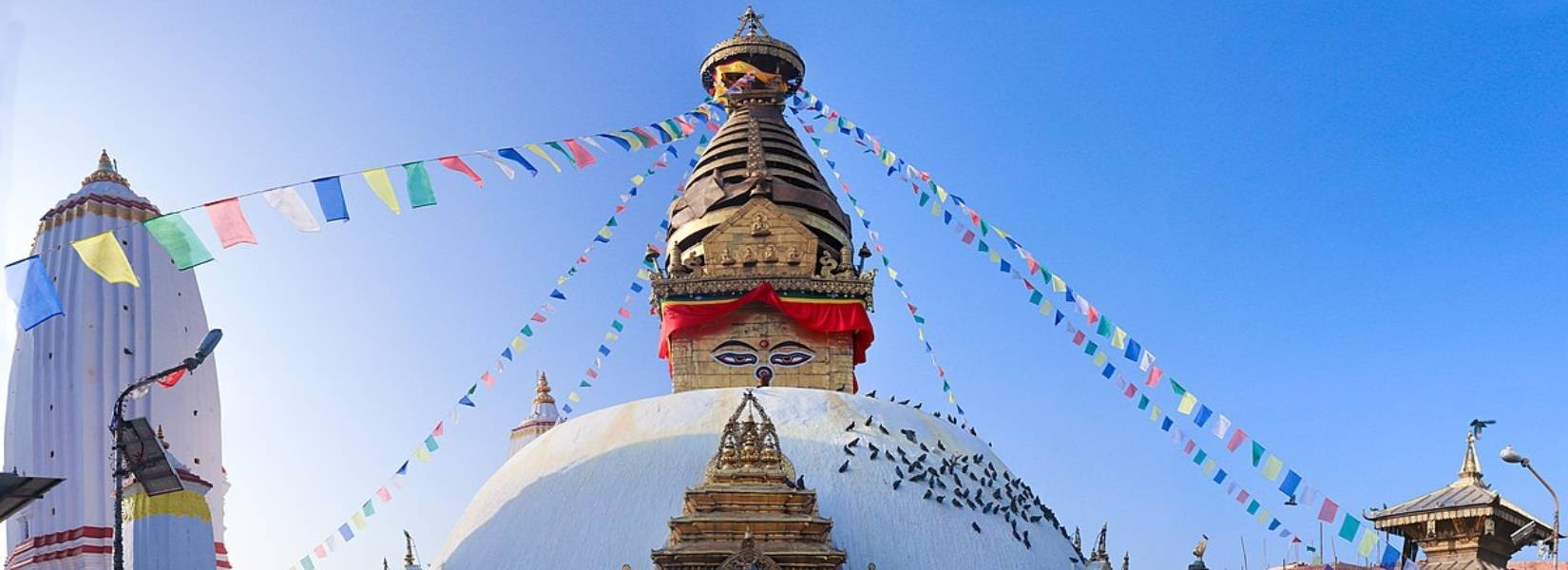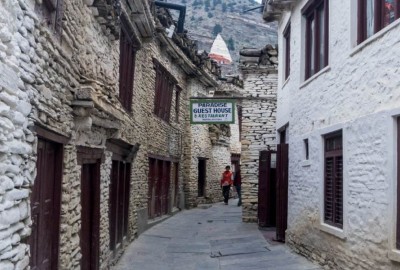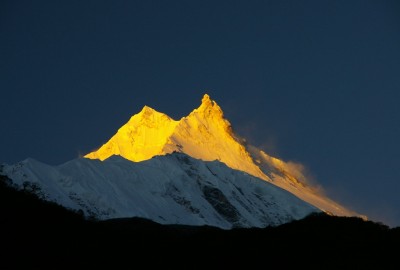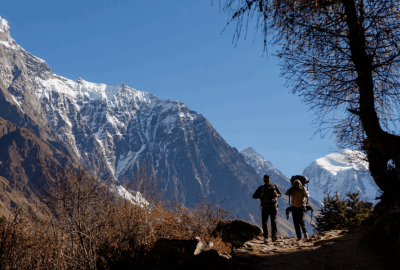Swayambhunath, popularly known as Monkey Temple. It is recognized as one of the oldest and possibly the most mysterious of all the shrines located in Kathmandu valley, Swayambhunath Stupa lies atop a conical wooden hill crowned by a golden spire. Visible from all sides of the valley are its golden glittering spire and dazzling white dome and is located 3 kilometers to the west of Thamel.
Table of Contents
Plan your trip to Nepal
Customize your trip with help from a local travel specialist.
Hundreds of monkeys scatter around the temple each night when the hundreds of pilgrims and priests that visit each day are gone, hence, it is also called the "Monkey Temple". These iconic monkeys can also be seen during the day but they are much more in number after the dusk. However, before you get to the main stupa, you have to climb the 365 stone steps which can be quite daunting and tiring.
Found by King Mahadeva at the beginning of the 5th century, Swayambhunath underwent major renovation done in 2010 to the temple. One of them was adding twenty kilograms of solid gold to the dome in order to rebuild it. During the April 25th Earthquake in Nepal, The Annapurna Shrine was destroyed. Furthermore, the monastery located at the back of the stupa was badly damaged as well. Other than that the vast majority of Swayambhunath managed to survive in one piece.
There are many important monuments that surround the Swayambhunath hill. A few of them are Pashupatinath, Changu Narayan, Dakshinkali and Budhanilkantha.
History of Swayambhunath
Swayambhunath Stupa was already an important destination for Buddhist pilgrims across Asia by the 5th century AD and its evidence has been given by the stone inscription which includes historical records etched onto it. Folklore, however, claims that the origin of Swayambhunath actually goes even further back; stating that it was here before the arrival of Buddhism in Kathmandu valley. A collection of myths about the site tells us the different ways in which it came into being. Swayambhu Purana of the 15th century tells that a miraculous lotus planted by a past Buddha bloomed in the lake that once was Kathmandu valley. The lotus is said to have radiated a brilliant light that was mysterious and hence got the name "Swayambhu" which means 'Self- Created'.
To see the mysterious and miraculous light which supposedly granted enlightenment, divinities, saints, and sages traveled for days to witness it firsthand. Legend also shares that the bewitching Swayambhu light was seen in a vision by the Bodhisattva Manjushri who was meditating at Wutai Shan, the sacred mountain. It is believed that Manjushri flew in his blue lion across the mountains of China and Tibet to worship the lotus. Feeling impressed by the power that radiated from the lotus, Manjushree felt that human pilgrims would be able to access the lotus more easily if the water were to be drained from the river. Hence, in the mountains surrounding the mountains, Manjushri cut a gorge with his greatsword. After the water drained away, what we now know as Kathmandu valley came into existence. The lotus was transferred to the hill and it is said that the light it radiated became Swayambhunath Stupa.
Places to Visit in Swayambhunath
Stairway to Swayambhunath
The Vajrayana Buddhists of northern Nepal and Tibet, the Newari Buddhists of Central and Southern Nepal and Hindus are all devout worshippers of Swayambhunath. The 365 steps that lead up to the hill is ascended by hundreds of pilgrims every morning before dawn. They walk past the gilded Vajra and the two lions guarding the entrance and circle the stupa in a clockwise rotation while the Newari Buddhists do it in the opposite direction (anticlockwise rotation). A pair of big eyes are on each of the four sides of the main stupa.
The eyes are supposed to represent the all-seeing perspective of God. Instead of a nose, there is a symbol of the Nepali one in the alphabet signifying that the Buddhist path is the single way to gain enlightenment. There is a third eye above each pair of eyes signifying the wisdom of looking within oneself. It is said that Buddha is not interested in hearing prayers of himself so the stupas have no ear.
Dorje at Swayambhunath Stupa
Temples, chaityas, painted pictures of deities and other religious objects are in the area surrounding the stupa. Small shrines with shamanistic deities and tantric statues are scattered all around the stupa. Shiva lingams, prayer wheels for the Tibetan Buddhists and a popular Hindu temple dedicated to the Goddess of smallpox and other epidemics, Harati can also be found there. The Shiva lingams have now been disguised as Buddhist chaityas and are decorated with faces of Dhyani Buddhas. The intermingling of deities of Buddhism and Hinduism in the development of religious trends of Nepal is signified by the Harati Devi temple. The Buddhists adopted for the assistance of the Hindu deity as they had no deity of their own to protect against dreaded smallpox.
Shantipur Shrine
Though it is less visited and is quite small, the Shantipur Shrine is quite fascinating. The name of this shrine translates into the 'Place of Peace'. In this temple, there is a secret residence always locked underneath the temple in which the Tantric master Santikar Acharya lived in the 8th century. He is said to have preserved his life for countless centuries by practicing meditation techniques. He was also believed to be a person who had complete control over the weather and was fabled as an arcane magician.
It is believed that the King of Kathmandu must enter the underground chamber to get the secret mandala from Shantikar when the Kathmandu valley is threatened by drought. The myth claims that rain will begin to fall as soon as the mandala is brought outside and shown to the sky. According to paintings etched in the walls, this last occurred in 1658. The temple is grim, mysterious and slightly portentous which gives it a powerful atmosphere.
How to Get to Swayambhunath
Walking
Swayambhunath stupa is about 60 to 90 minutes' walk from Thamel. If the weather is just right then you'll be able to get there without any hassle and can view the city streets along the way.
Buses
You can get a bus to Swayambhunath from Ratna Park bus park. While the buses are often crowded, they are considerably cheap. It will take around half an hour to an hour to get to Swayambhunath but it depends on the traffic that day.
Taxi
It takes about 15-20 minutes to get from Thamel to the temple in favorable traffic. While it is more expensive than buses, it will be more comfortable.
Entrance Fee:
- SAARC Nationals: Rs.50
- Forgein Countries: Rs.200








